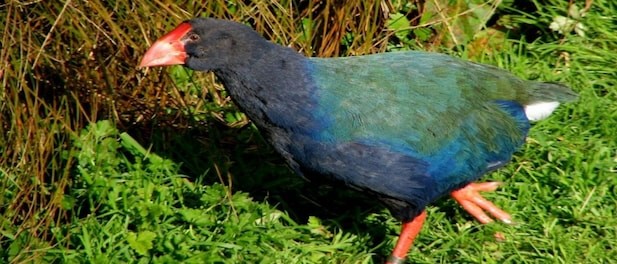Description

Disclaimer: Copyright infringement not intended.
Context
- The Takahē bird, once thought to be extinct, has made a remarkable comeback in New Zealand's South Island.
- This large flightless bird's return signifies a significant achievement for conservation efforts in the region.
-
Details
- The South Island Takahē (Porphyrio hochstetteri) is a remarkable flightless swamphen endemic to New Zealand, belonging to the rail family.
Reintroduction of the Takahē
- According to a report, 18 Takahē birds were recently reintroduced into the Lake Wakatipu valley on the South Island.
- These birds hadn't been spotted in this alpine area for nearly a century.
- Takahē birds are characterized by their large size (around 50 centimeters) and have been part of New Zealand's ecosystem since the prehistoric Pleistocene era.

Unique History and Challenges
- Takahē birds evolved in an environment without native land mammals, adapting to ecological niches usually occupied by mammals.
- In 1898, they were declared extinct due to introduced animals like stoats, cats, ferrets, and rats, which devastated their population.
- Rediscovered in 1948, their numbers have been steadily increasing, growing at about eight percent per year.
Taxonomy and Naming
- The South Island Takahē is the largest living member of the rail family and is also known by its abbreviated name, which it shares with the now-extinct North Island Takahē.
- It is scientifically known as Porphyrio hochstetteri and is occasionally referred to by its Māori name "notornis."
Conservation Efforts
- The New Zealand Department of Conservation (DOC) manages the Takahē Recovery Programme, which has saved the species from the brink of extinction.
- Conservationists have established protected populations on offshore islands and select mainland sites, such as the Takahē Valley and Kahurangi National Park.
- Breeding programs, including incubating eggs and raising chicks, have been crucial in increasing the population.
Habitat and Behavior
- The South Island Takahē thrives in alpine grasslands, adapting to life in both grasslands and forests.
- It is territorial and non-migratory, adapting its behavior to the changing seasons.
- The bird primarily consumes grass, shoots, insects, and the leaves of alpine grass species.
Physical Characteristics
- The Takahē is a large, robust bird, measuring approximately 50 centimeters in length.
- It features striking blue and green plumage on its back, with a distinctive red frontal shield on its forehead.
- Despite being flightless, the Takahē has adapted strong legs and feet, enabling it to navigate the rugged terrains of its native habitat.
Predator Control Efforts
- Predator control efforts, such as trapping stoats, ferrets, and feral cats, have been crucial to the Takahē's survival.
- Reduction in predator numbers in the area has created a safer environment for these endangered birds.
New Zealand's Conservation Commitment
- New Zealand aims to eliminate damaging introduced predators, like rats, possums, and stoats, by 2050.
- Trapping endeavors are expanding, allowing rare species to return to their natural habitats beyond sanctuary confines.
|
PRACTICE QUESTION
Q. Which of the following statements about the South Island Takahē is/are correct?
1.The South Island Takahē (Porphyrio hochstetteri) was rediscovered in the Murchison Mountains after being officially declared extinct in 1898.
2.The primary habitat of the South Island Takahē is tropical rainforests.
3.Conservation efforts for the South Island Takahē include captive breeding and reintroduction to predator-free islands.
Options:
a) Statements 1 and 3 are correct.
b) Statements 1 and 2 are correct.
c) Statements 2 and 3 are correct.
d) Statements 1, 2, and 3 are correct.
Answer: a)
|

https://www.cnbctv18.com/environment/prehistoric-bird-declared-extinct-decades-ago-makes-return-to-the-forests-of-new-zealand-17668471.htm












